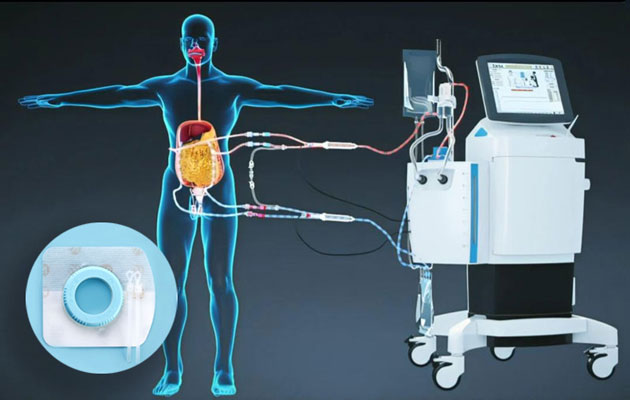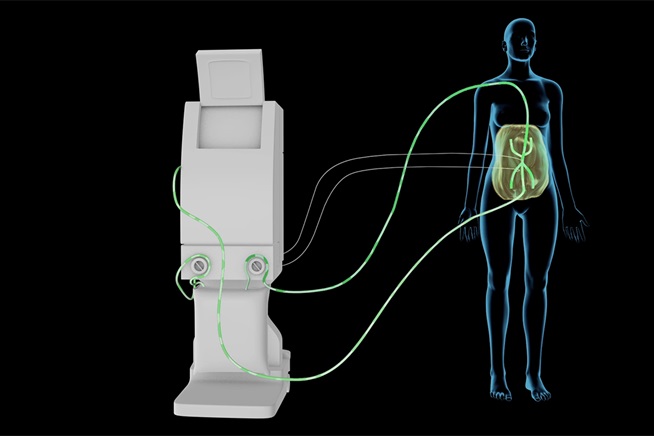
What is HIPEC Surgery?
HIPEC stands for Hyperthermic Intraperitoneal Chemotherapy. The procedure involves two main components: the surgical removal of cancerous tissue within the abdominal cavity and the infusion of heated chemotherapy directly into the peritoneal cavity. The goal is to eliminate any remaining cancer cells that cannot be seen by the naked eye, as standard chemotherapy treatments are not always effective against cancer cells that have spread throughout the abdomen.
HIPEC is particularly used for cancers that originate in or spread to the peritoneal cavity, such as peritoneal mesothelioma, appendiceal cancer, colon cancer, and ovarian cancer. The chemotherapy drugs are heated to temperatures between 41-43 degrees Celsius (105.8-109.4 degrees Fahrenheit), which increases their effectiveness in killing cancer cells while minimizing damage to healthy tissues.
How Does HIPEC Work?

HIPEC is a two-step process. The first step involves performing surgery to remove as much visible tumor mass as possible. This is a critical aspect of the treatment, as it eliminates large tumors that can be seen or felt during surgery. The extent of tumor removal depends on the individual patient’s case, and the surgeon will aim to remove as much of the cancerous tissue as possible to reduce the risk of recurrence.
Once the tumors are removed, the second step begins. The patient is given a warm infusion of chemotherapy drugs directly into the abdominal cavity. This is usually done through catheters that allow for precise delivery of the drugs to the affected area. The chemotherapy solution is heated to high temperatures to enhance the drug’s effectiveness and kill any remaining cancer cells that may have spread throughout the peritoneum.
This method differs significantly from traditional chemotherapy because the chemotherapy drugs are administered directly to the affected area, and the heat enhances their ability to penetrate and destroy cancer cells.
Indications for HIPEC Surgery
HIPEC is not a one-size-fits-all treatment. It is a highly specialized procedure that is only appropriate for certain types of cancer and patients. The following are the main cancer types and conditions for which HIPEC may be considered:
1. Colorectal Cancer with Peritoneal Metastasis
Colorectal cancer is one of the most common types of cancer that can spread to the peritoneum, a condition known as peritoneal metastasis. When colorectal cancer spreads to the abdominal cavity, it can form multiple small tumors, making it challenging to treat with traditional surgery or chemotherapy alone. In such cases, HIPEC may be used to treat the peritoneal spread after removing the primary tumor. By targeting both the primary and metastatic cancer cells with heated chemotherapy, HIPEC offers the potential for extended survival and better outcomes.
2. Ovarian Cancer
Ovarian cancer is another type of cancer that can spread to the peritoneum. While surgery can remove primary tumors in the ovaries, the disease often spreads to other parts of the abdominal cavity, making it difficult to eliminate all cancer cells. HIPEC can be used in combination with surgery to target any remaining cancer cells that might not be visible to the surgeon. It is typically used for patients with advanced ovarian cancer that has not responded well to conventional treatments.
3. Appendiceal Cancer
Appendiceal cancer is a rare type of cancer that originates in the appendix but can spread to the peritoneum. For patients with appendiceal cancer that has spread, HIPEC may offer a chance to control the disease. The procedure has shown positive results for patients with peritoneal dissemination of appendiceal cancer, improving their prognosis and survival rates.
4. Peritoneal Mesothelioma
Mesothelioma is a cancer primarily caused by asbestos exposure that affects the lining of the lungs, but it can also develop in the peritoneum. When mesothelioma affects the peritoneal cavity, it can be challenging to treat with conventional chemotherapy. HIPEC has shown promise in improving the outcomes for patients with peritoneal mesothelioma by delivering heated chemotherapy directly to the affected area.
5. Gastric Cancer
Gastric cancer, or stomach cancer, can also spread to the peritoneum, especially in advanced stages. For patients with peritoneal metastasis from gastric cancer, HIPEC may be used in combination with surgery to eliminate remaining cancer cells in the abdominal cavity. This combined approach can improve survival and reduce the risk of cancer recurrence.
Patient Selection Criteria for HIPEC Surgery
While HIPEC is an effective treatment option for certain cancers, it is not suitable for everyone. A thorough evaluation of the patient’s overall health, cancer stage, and specific condition is essential to determine if HIPEC is the right choice. The following are some of the key factors that are considered when selecting patients for HIPEC surgery:

1. Tumor Resectability
The primary requirement for HIPEC surgery is the ability to surgically remove visible tumors. If the tumors are too widespread or cannot be surgically resected, HIPEC may not be an effective treatment option. Surgeons will assess the patient’s tumor burden and determine whether it is possible to remove enough cancerous tissue to make the procedure beneficial.
2. Overall Health and Fitness
HIPEC is a complex and demanding procedure that requires the patient to be in good overall health to tolerate both the surgery and the chemotherapy. Patients who have other serious health conditions, such as cardiovascular or respiratory issues, may not be suitable candidates for HIPEC. Preoperative evaluation of the patient’s physical fitness is essential to ensure they can withstand the demands of the procedure.
3. Absence of Distant Metastasis
HIPEC is generally reserved for patients whose cancer has not spread to distant organs, such as the liver, lungs, or brain. If the cancer has metastasized beyond the peritoneal cavity, the chances of a successful outcome from HIPEC decrease significantly. This is because the treatment is specifically designed to target cancer that is confined to the abdominal cavity.
4. Performance Status
The performance status of the patient refers to their ability to carry out normal activities of daily living. A higher performance status indicates that the patient is more likely to recover from the surgery and chemotherapy. Patients with a lower performance status may face more challenges in recovery and may not benefit from the procedure.
Benefits of HIPEC Surgery
For patients who are eligible, HIPEC offers several potential benefits over traditional chemotherapy:
- Direct Targeting of Cancer Cells: HIPEC allows for chemotherapy to be delivered directly to the affected area, ensuring that the cancer cells in the peritoneum receive the maximum dose of chemotherapy.
- Improved Survival Rates: Studies have shown that patients who undergo HIPEC in combination with surgery have improved survival rates compared to those who only receive standard chemotherapy.
- Reduced Risk of Recurrence: By targeting both visible tumors and microscopic cancer cells, HIPEC reduces the risk of recurrence in the peritoneal cavity, which is a common site for metastasis.
HIPEC is a promising and effective treatment for certain advanced cancers that involve the peritoneal cavity. When combined with surgery, HIPEC provides an opportunity to eliminate both visible and microscopic tumors, improving survival rates and quality of life for patients. However, not all patients are candidates for this procedure, and a thorough evaluation by a multidisciplinary team is necessary to determine the appropriateness of HIPEC.
This treatment approach has shown significant benefits in specific cancer types such as colorectal, ovarian, and mesothelioma cancers, making it a valuable tool in the fight against peritoneal metastasis. As with any medical treatment, patients must work closely with their healthcare providers to understand the risks, benefits, and alternatives available.




